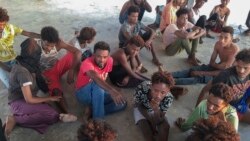On October 1, the Interior Ministry of Libya’s U.N.-backed Government of National Accord (GNA), based in the capital Tripoli, launched what it described as a security campaign against criminals and illegal migrants in the area of Gargaresh. That is a hub for migrants and asylum-seekers located about 12km (7.5 miles) west of Tripoli.
Police rounded up more than 5,000 people, including women and children, and put them in detention centers.
Oil-rich Libya is a major transit point to Europe for migrants escaping war and poverty in their countries. The U.N. estimated that there were 597,611 migrants in Libya as of the end of July, including 3,860 in detention centers and 42,210 registered refugees and asylum-seekers.
In 2011, NATO-backed rebels ousted and killed Muammar Gaddafi, who had ruled Libya for 40 years. Since then, Libya has been divided between the GNA in eastern Libya and the Tobruk administration in the western part of the country. The latter is supported by the Libyan National Army (LNA) under command of General Khalifa Haftar, a Libyan-American.
The warring parties reached a nationwide ceasefire in 2020. A transitional government backed by the United Nations was formed earlier this year, with elections set for December.
After launching the October 1 raid, the GNA’s Interior Ministry tweeted that “Deputy Prime Minister Ramadan Abu Jinnah ... visited Gargaresh area to follow up the security campaign in the area launched at dawn today to arrest criminals and alcohol, drug dealers."
But that is misleading based on concerns raised by the United Nations and rights activists. The detained migrants were beaten and pushed around with heads bowed and hands tied. Many of those arrested are torture survivors and pregnant women, some of whom have been trapped for years in a cycle of trafficking and exploitation.
On October 2, the United Nations Support Mission in Libya (UNSMIL) flagged reports of killings and the use of “excessive use of force against migrants and asylum seekers in Gargaresh, Tripoli.” The U.N. said migrants were harassed in their homes, beaten and shot. Communications went down, leaving individuals unable to reach out for assistance.
The mission said the raid targeted makeshift migrant shelters in the Gargaresh area.
Ahmed Abdul Hakim Hamza, the head of the National Commission for Human Rights in Libya, told the Voice of America that most of the arrested migrants and asylum seekers were registered with the U.N. refugee agency and recognized as refugees by the Libyan government.
He added that the U.N. and the International Organization for Migration (IOM) rent buildings in the Gargaresh area to house migrants temporarily until their cases are adjudicated and they are allowed either to return voluntarily to their home countries or resettle elsewhere.
“Detention centers are crowded and riddled with violations and abuses without minimum humanitarian treatment. Such campaigns against migrants should stop, especially when migrants are already registered with the U.N.,” Hamza said.
Hamza added that the Libyan government needs help dealing with migrants in line with humanitarian and legal principles and assistance fighting cross-border human trafficking.
In July, Amnesty International released a report documenting “patterns of human rights violations, including severe beatings, sexual violence, extortion, forced labour, and inhuman conditions across seven DCIM centres in Libya.”
Amnesty noted that in the Abu Issa center in the city of al-Zawiya, “detainees reported being deprived of nutritious food to the point of starvation.”
Amnesty also highlighted the ongoing complicity of European countries that continue to support Libyan coast guard operations to intercept, capture and forcefully return migrants to “the hellscape of detention” in Libya.
In February 2017, Italy signed a Memorandum of Understanding with the U.N.-backed Libyan government to restrict the flow of Europe-bound migrants. The deal committed Italy and the European Union to train and fund Libya’s coast guard.
A migration crisis erupted in 2015 and 2016, when a million refugees from Syria, Iraq, Afghanistan and other countries sought refuge in Europe. Countries in the front lines of the crisis like, Greece and Italy, took tough measures with the support of the European Union. Recently, the Taliban takeover of Kabul has increased fears of a new refugee source.
In an open letter to the Italian government, a number of international organizations. including Amnesty International, Save the Children and Oxfam Italy, said the Memorandum of Understanding between Italy and the U.N.-backed Libyan government should be revoked.
“Italy and the entire European Union must be aware that they are carrying out collective push backs of people fleeing war and persecution and that they are also financing the concentration camp system in Libya,” the appeal stated.
In September, the IOM said the Libyan coast guard had intercepted 24,000 Europe-bound migrants in the Mediterranean since the start this year, but only 6,000 are accounted for in official detention centers. The fates of thousands of migrants remain unknown.
On October 4, the U.N.-led Independent Fact-Finding Mission on Libya reported that since 2016, all the warring parties in Libya have likely committed war crimes against civilians, internally displaced people and immigrants.
“Violations against migrants are committed on a widespread scale by State and non-State actors, with a high level of organization and with the encouragement of the State – all of which is suggestive of crimes against humanity,” the report said.
Reacting to the roundups in Gargaresh, the U.S. Embassy in Libya called on authorities to respect human rights and investigate alleged violations.
“The human rights and dignity of all people, including migrants and asylum-seekers, must remain a priority of all governments,” the embassy said on Twitter. “The events in Gargaresh raise alarm and should immediately be investigated.”






